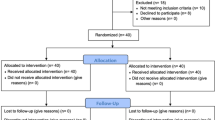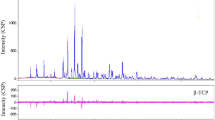Abstract
Objectives
This study aims to evaluate the effect of adding bone substitute materials (BSM) to particulated autogenous bone (PAB) on the volume fraction (Vf) of newly formed bone after maxillary sinus augmentation.
Materials and methods
Thirty healthy patients undergoing maxillary sinus augmentation were included. PAB (N = 10), mixtures of PAB and beta-tricalciumphosphate (PAB/β-TCP) (N = 10), as well as PAB and β-TCP and hydroxyapatite (PAB/HA/β-TCP) (N = 10) were randomly used for sinus augmentation. A sample of the graft material was maintained from each patient at time of maxillary sinus augmentation, and Vfs of the PAB and/or BSM in the samples were determined by means of microcomputerized tomography (μ-CT). Five months later, samples of the grafted areas were harvested during implantation using a trephine bur. μ-CT analysis of these samples was performed, and the Vf of bone and BSM were compared with the data obtained 5 months earlier from the original material.
Results
The mean Vf of the bone showed a statistically significant increase (p < 0.05) in all groups after a healing period of 5 months without statistically significant difference between the groups.
Conclusions
With regard to the increase of bone volume, it is not relevant if PAB is used alone or combined with β-TCP or HA/β-TCP.
Clinical relevance
The amount of PAB and associated donor site morbidity may be reduced by adding BSM for maxillary sinus augmentation.





Similar content being viewed by others
References
Boyne PJ, James RA (1980) Grafting of the maxillary sinus floor with autogenous marrow and bone. Int J Oral Maxillofac Surg 38:613–661
Tatum OH (1986) Maxillary and sinus implant reconstruction. Dent Clin N Am 30:207–229
Huerzeler MB, Kirsch A, Ackermann KL, Quinones CR (1996) Reconstruction of the severely resorbed maxilla with dental implants in the augmented maxillary sinus: a 5-year clinical investigation. Int J Oral Maxillofac Implants 11:466–475
Wallace ST, Froum ST (2003) Effect of maxillary sinus augmentation on the survival of endosseous dental implants. A systematic review. Ann Periodontol 8:328–343
Kreisler M, Moritz O, d'Hoedt B (2006) Evidence-based medicine in sinus floor elevation part 1: general aspects and the influence of the grafting material on implant prognosis. J Dent Implantol 22:299–323
Kreisler M, Moritz O, d'Hoedt B (2007) Evidence-based medicine in sinus floor elevation part 2: direct and indirect factors in sinus floor elevation and their influence on implant prognosis. J Dent Implantol 23:68–86
Froum SJ, Tarnow DP, Wallace SS, Rohrer MD, Cho SC (1998) Sinus floor elevation using bovine bone mineral (OsteoGraf/N) with and without autogenous bone: a clinical, histologic, radiographic and histomorphometric analysis—part 2 of an ongoing prospective study. Int J Periodonics Restor Dent 18:528–543
Hallman M, Sennerby L, Lundgren S (2002) A clinical and histologic evaluation of implant integration in the posterior maxilla after sinus floor augmentation with autogenous bone, bovine hydroxyapatite, or a 20:80 mixture. Int J Oral Maxillofac Implants 17:635–643
Schlegel KA, Fichtner G, Schultze-Mosgau S, Wiltfang J (2003) Histologic findings in sinus augmentation with autogenous bone chips versus a bovine substitute material. Int J Oral Maxillofac Implants 18:53–58
Hatano N, Shimizu Y, Ooya K (2004) A clinical long-term radiographic evaluation of graft height changes after maxillary sinus floor augmentation with a 2:1 autogenous/xenograft mixture and simultaneous placement of dental implants. Clin Oral Implants Res 15:339–345
Guarnieri R, Grassi R, Ripari M, Pecora G (2006) Maxillary sinus augmentation using granular calcium sulfate (surgiplaster sinus): radiographic and histologic study at 2 years. Int J Periodontics Restorative Dent 26:79–85
Wanschitz F, Figl M, Wagner A, Ewers R (2006) Measurement of volume changes after sinus floor augmentation with phycogenic hydroxyapatite. Int J Oral Maxillofac Implants 21:422–438
Johansson LA, Isaksson S, Lindh C, Becktor JP, Sennerby L (2010) Maxillary sinus floor augmentation and simultaneous implant placement using locally harvested autogenous bone chips and bone debris: a prospective clinical study. Int J Oral Maxillofac Implants 68:837–844
Yildirim M, Spiekermann H, Biesterfeld S, Edelhoff D (2000) Maxillary sinus augmentation using xenogenic bone substitute material Bio-Oss® in combination with venous blood. A histologic and histomorphometric study in humans. Clin Oral Implants Res 11:217–229
Maiorana C, Sigurta D, Mirandola A, Garlini G, Santoro F (2006) Sinus elevation with alloplast or xenogenic materials and implants: an up-to-4-year clinical and radiologic follow-up. Int J Oral Maxillofac Implants 21:426–432
Esposito M, Grusovin MG, Rees J, Karasoulos D, Felice P, Alissa R et al (2010) Interventions for replacing missing teeth: augmentation procedures of the maxillary sinus. Cochrane Database Syst Rev 3:CD008397
Froum SJ, Wallace SS, Cho SC, Elian N, Tarnow DP (2008) Histomorphometric comparison of a biphasic bone ceramic to anorganic bovine bone for sinus augmentation: 6- to 8-month postsurgical assessment of vital bone formation. A pilot study. Int J Periodontics Restorative Dent 28:273–281
Cordaro L, Bosshardt DD, Palattella P, Rao W, Serino G, Chiapasco M (2008) Maxillary sinus grafting with Bio-Oss® or Straumann® Bone Ceramic: histomorphometric results from a randomized controlled multicenter clinical trial. Clin Oral Implants Res 19:796–803
Artzi Z, Kozlovsky A, Nemcovsky CE, Weinreb M (2005) The amount of newly formed bone in sinus grafting procedures depends on tissue depth as well as the type and residual amount of the grafted material. J Clin Periodontol 32:193–199
Huerzeler MB, Quinones CR, Kirsch A, Schupbach P, Krausse A, Strub JC et al (1997) Maxillary sinus augmentation using different grafting materials and dental implants in monkeys. Part III. Evaluation of autogenous bone combined with porous hydroxyapatite. Clin Oral Implants Res 8:401–411
Scarano A, Degidi M, Iezzi G, Pecora G, Pattelli M, Orsini G et al (2006) Maxillary sinus augmentation with different biomaterials: a comparative histologic and histomorphometric study in man. Implant Dent 15:197–207
Suba Z, Takacs D, Matusovits D, Barabas J, Fazekas A, Szabo G (2006) Maxillary sinus floor grafting with ß-tricalcium phosphate in humans: density and microarchitecture of the newly formed bone. Clin Oral Implants Res 17:102–108
Burchardt H (1983) The biology of bone graft repair. Clin Orthop Relat Res 174:28–42
van den Bergh JP, ten Bruggenkate CM, Krekeler G, Tuinzing DB (1998) Sinusfloor elevation and grafting with autogenous iliac crest bone. Clin Oral Implants Res 9:429–435
Frenken JWFH, Bouwman WF, Bravenboer N, Zijderveld SA, Schulten EAJM, Bruggenkate CM (2010) The use of Straumann® Bone Ceramic in maxillary sinus floor elevation procedure: a clinical, radiological, histological and histomorphometric evaluation with a 6-month healing period. Clin Oral Implants Res 21:201–208
Jensen OT, Shulman LB, Block MS, Iacono VJ (1998) Report of the Sinus Consensus Conference of 1996. Int J Oral Maxillofac Implants 13:11–45
Tong DC, Rioux K, Drangsholt M, Beirne OR (1998) A review of survival rates for implants placed in grafted maxillary sinuses using metaanalysis. Int J Oral Maxillofac Implants 13:175–182
Kühl S, Götz H, Hansen T, Kreisler M, Behneke A, Heil U et al (2010) Three-dimensional analysis of bone formation after maxillary sinus augmentation by means of microcomputed tomography: a pilot study. Int J Oral Maxillofac Implants 25:930–938
Artzi Z, Weinreb M, Carmeli G, Lev-Dor R, Dard M, Nemcovsky CE (2010) Histomorphometric assessment of bone formation in sinus augmentation utilizing a combination of autogenous and hydroxyapatite/biphasic tricalcium phosphate graft materials: at 6 and 9 month in humans. Clin Oral Implants Res 19:686–692
Acknowledgments
The study was partly funded by a study grant of the University of Mainz (MAIFOR). We extend our gratitude to Prof. Dr. Heinz Duschner for the facilities in terms of μ-CT acquisition and Irene Mischak for the statistical analysis.
Conflict of interests
The authors declare that they have no conflict of interests.
Author information
Authors and Affiliations
Corresponding author
Rights and permissions
About this article
Cite this article
Kühl, S., Brochhausen, C., Götz, H. et al. The influence of bone substitute materials on the bone volume after maxillary sinus augmentation: a microcomputerized tomography study. Clin Oral Invest 17, 543–551 (2013). https://doi.org/10.1007/s00784-012-0732-2
Received:
Accepted:
Published:
Issue Date:
DOI: https://doi.org/10.1007/s00784-012-0732-2




